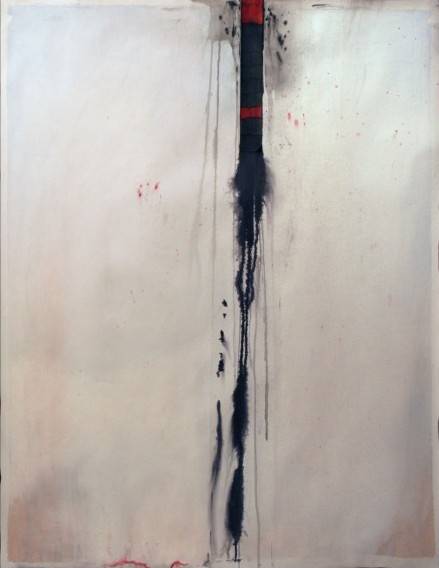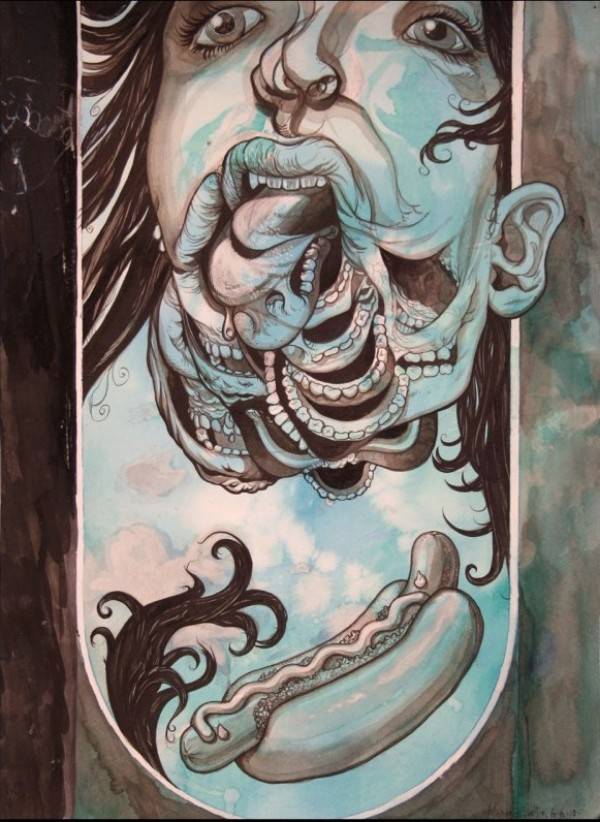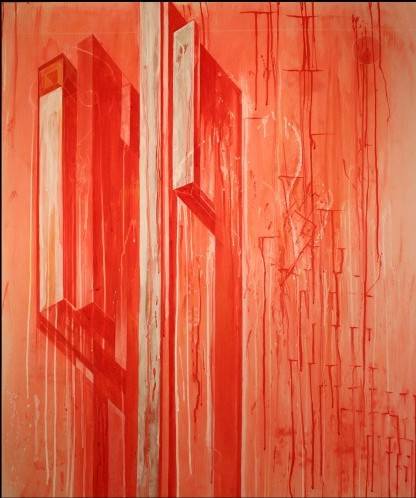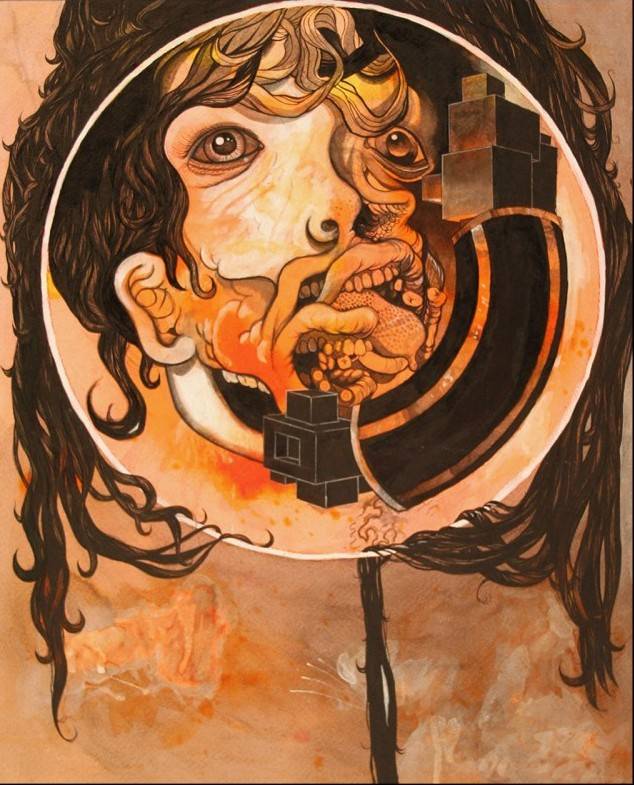Monolith Reception | Indi Go | Friday | 6 p.m. – 9 p.m. | Free Cocktails/Hor d’oeuvres
 It’s not exactly fair to call Michael Curtin a newcomer to the C-U art scene. He’s also not quite a veteran. As a townie, a resident of downtown Champaign and a graduate of the U of I’s school of Art & Design, Curtin has been around the scene for longer than many of the folks who end up showing their art in town. And yet, as Curtin prepares to open his first major show at Indi Go this Friday, his perspective transcends both C-U and the U of I. He owes some of his perspective to the nearly two years he spent traveling across the country, living in hotels; some of it clearly derives from the comic books that he still buys weekly, downtown at G-Mart.
It’s not exactly fair to call Michael Curtin a newcomer to the C-U art scene. He’s also not quite a veteran. As a townie, a resident of downtown Champaign and a graduate of the U of I’s school of Art & Design, Curtin has been around the scene for longer than many of the folks who end up showing their art in town. And yet, as Curtin prepares to open his first major show at Indi Go this Friday, his perspective transcends both C-U and the U of I. He owes some of his perspective to the nearly two years he spent traveling across the country, living in hotels; some of it clearly derives from the comic books that he still buys weekly, downtown at G-Mart.
What emerges from this confluence of experience and perspective is a unique world made up of two seemingly disparate aesthetics and two seemingly disparate subjects that Curtin unifies through his understanding of that world. Vacillating between abstract representations of geometric shapes that loom large upon the enormous pieces of stretched paper he paints on, and highly detailed if also eerily surreal renderings of the human form, this understanding seems rooted in the uncanny: Curtin does not so much change his subject as he allows it to be changed, to morph into an essentialized or an embellished version of itself: something that both is and is not itself. In this respect, Curtin’s images instruct us, unnerve us, and yes, even change us.
 Your work seems to vacillate between two aesthetics: one, a kind of organic surrealism, and the other, a much more structured abstract expressionism. It’s incredible to me that, despite seeming very stylistically disparate, the two seem to flow naturally in and out of one another. Do you have to work at connect these two aesthetics, or does it happen naturally?
Your work seems to vacillate between two aesthetics: one, a kind of organic surrealism, and the other, a much more structured abstract expressionism. It’s incredible to me that, despite seeming very stylistically disparate, the two seem to flow naturally in and out of one another. Do you have to work at connect these two aesthetics, or does it happen naturally?
While I did not make a specific effort to visually sell the work as being directly interconnected, I did maintain a common approach to all of the arts development. All of the pieces are a result of my focusing on a particular element, be it a human tooth, a right-angle or a splash of paint, and allowing that component to drive the evolution of the composition.
How much control do you feel like you have over how a piece evolves?
I make stylistic choices that are informed by the subject matter of the piece, and I’m constantly reacting to the current conditions on the paper. So while I may have a broad concept in mind, the details, and how they effect the overall look and feel of the piece, are a byproduct of the process itself. This is beneficial to me, because I can work on a painting for 30 hours and still thoroughly enjoy looking at it; despite the fact that I painted it I can appreciate it as art that is wholly separate from myself.
Is it common for you to spend that much time on a single painting?
The time spent varies greatly between the different styles. If I’m making a medium-sized piece (2′ X 2′) with a lot of highly rendered organic elements it can take up to 15 hours. However if I’m working with simple geometric shapes then I can complete even a very large piece (4′ X 5′) in less then 5 hours. Where I get into trouble is when I choose to work both detailed and big, in which case a piece can take well over 30 hours. That said, I am working faster now then I did when I started building up the body of work up for this show.
 You spent about two years on the road, living in hotel rooms and driving around all different parts of the country. Does that experience ever show up in your art?
You spent about two years on the road, living in hotel rooms and driving around all different parts of the country. Does that experience ever show up in your art?
Absolutely. All of the figurative work had it’s roots in sketches I did while traveling, and several of the medium-sized pieces were made while on the road. Both the feelings of seclusion and the desire to live fully when experiencing a new place worked their way into the art as isolation and overcompensation / outright hedonism.
While the content does not reflect any specific location, I can look at the work and vividly remember the four or five states and the dozen some-odd cities the art was created within. Travel in general is incredibly rewarding, and getting to paint while doing so crystallized those moments for me in a way that I never expected.
You’re holding a reception this Friday. It’s free and there’s booze, which is standard, but there’s also music. How did you get Water Between Continents on board? How do you see them as fitting in with the work?
I’m lucky enough to count Brian Reedy amongst my friends, and doubly lucky that he and Nick Rudd were available to play at the opening. Without overstating anything, I couldn’t imagine anyone else performing. I’ve drawn a great deal of inspiration from how they conduct themselves as musicians; their desire to dig deep and really uncover something is readily evident when they’re onstage. It’s something that I strive to do when I paint, and so their involvement with the reception feels very right. Brian was also, both as a friend and as an amazing painter, incredibly encouraging when I first started discussing what would eventually became Monolith.
 Finally, what are your goals are for Monolith?
Finally, what are your goals are for Monolith?
From the beginning I had a gallery presentation in mind, so this body of work differs from what I typically do in that it’s focused on presenting a large and cohesive visual payload. As it was developed for a gallery setting, I wanted to almost exclusively work big, and with lots of bold, primary colors. Stylistically I drew inspiration from epic space-drama’s, and I think that comes through in the saturated tones and general posture of many of the pieces. Overall this work is meant to be enjoyed by others, and having it up at Indi Go is a great way to accomplish that.








